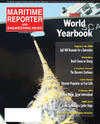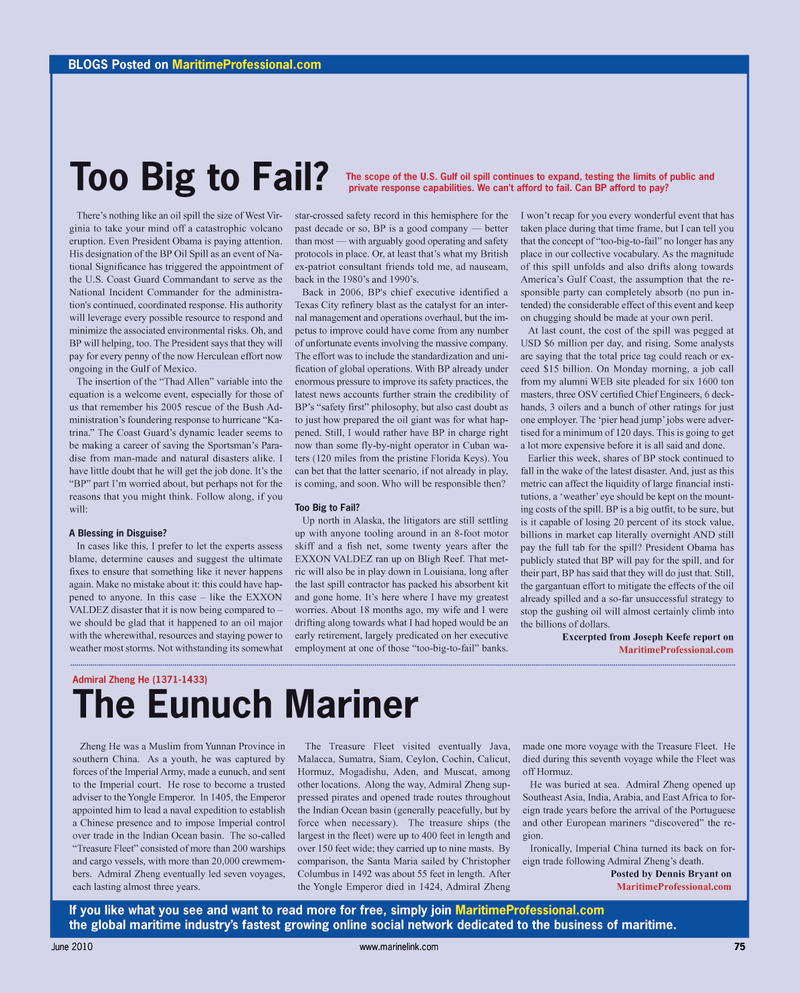
Page 75: of Maritime Reporter Magazine (June 2, 2010)
Read this page in Pdf, Flash or Html5 edition of June 2, 2010 Maritime Reporter Magazine
There’s nothing like an oil spill the size of West Vir- ginia to take your mind off a catastrophic volcano eruption. Even President Obama is paying attention.
His designation of the BP Oil Spill as an event of Na- tional Significance has triggered the appointment of the U.S. Coast Guard Commandant to serve as the
National Incident Commander for the administra- tion's continued, coordinated response. His authority will leverage every possible resource to respond and minimize the associated environmental risks. Oh, and
BP will helping, too. The President says that they will pay for every penny of the now Herculean effort now ongoing in the Gulf of Mexico.
The insertion of the “Thad Allen” variable into the equation is a welcome event, especially for those of us that remember his 2005 rescue of the Bush Ad- ministration’s foundering response to hurricane “Ka- trina.” The Coast Guard’s dynamic leader seems to be making a career of saving the Sportsman’s Para- dise from man-made and natural disasters alike. I have little doubt that he will get the job done. It’s the “BP” part I’m worried about, but perhaps not for the reasons that you might think. Follow along, if you will:
A Blessing in Disguise?
In cases like this, I prefer to let the experts assess blame, determine causes and suggest the ultimate fixes to ensure that something like it never happens again. Make no mistake about it: this could have hap- pened to anyone. In this case – like the EXXON
VALDEZ disaster that it is now being compared to – we should be glad that it happened to an oil major with the wherewithal, resources and staying power to weather most storms. Not withstanding its somewhat star-crossed safety record in this hemisphere for the past decade or so, BP is a good company — better than most — with arguably good operating and safety protocols in place. Or, at least that’s what my British ex-patriot consultant friends told me, ad nauseam, back in the 1980’s and 1990’s.
Back in 2006, BP's chief executive identified a
Texas City refinery blast as the catalyst for an inter- nal management and operations overhaul, but the im- petus to improve could have come from any number of unfortunate events involving the massive company.
The effort was to include the standardization and uni- fication of global operations. With BP already under enormous pressure to improve its safety practices, the latest news accounts further strain the credibility of
BP’s “safety first” philosophy, but also cast doubt as to just how prepared the oil giant was for what hap- pened. Still, I would rather have BP in charge right now than some fly-by-night operator in Cuban wa- ters (120 miles from the pristine Florida Keys). You can bet that the latter scenario, if not already in play, is coming, and soon. Who will be responsible then?
Too Big to Fail?
Up north in Alaska, the litigators are still settling up with anyone tooling around in an 8-foot motor skiff and a fish net, some twenty years after the
EXXON VALDEZ ran up on Bligh Reef. That met- ric will also be in play down in Louisiana, long after the last spill contractor has packed his absorbent kit and gone home. It’s here where I have my greatest worries. About 18 months ago, my wife and I were drifting along towards what I had hoped would be an early retirement, largely predicated on her executive employment at one of those “too-big-to-fail” banks.
I won’t recap for you every wonderful event that has taken place during that time frame, but I can tell you that the concept of “too-big-to-fail” no longer has any place in our collective vocabulary. As the magnitude of this spill unfolds and also drifts along towards
America’s Gulf Coast, the assumption that the re- sponsible party can completely absorb (no pun in- tended) the considerable effect of this event and keep on chugging should be made at your own peril.
At last count, the cost of the spill was pegged at
USD $6 million per day, and rising. Some analysts are saying that the total price tag could reach or ex- ceed $15 billion. On Monday morning, a job call from my alumni WEB site pleaded for six 1600 ton masters, three OSV certified Chief Engineers, 6 deck- hands, 3 oilers and a bunch of other ratings for just one employer. The ‘pier head jump’ jobs were adver- tised for a minimum of 120 days. This is going to get a lot more expensive before it is all said and done.
Earlier this week, shares of BP stock continued to fall in the wake of the latest disaster. And, just as this metric can affect the liquidity of large financial insti- tutions, a ‘weather’ eye should be kept on the mount- ing costs of the spill. BP is a big outfit, to be sure, but is it capable of losing 20 percent of its stock value, billions in market cap literally overnight AND still pay the full tab for the spill? President Obama has publicly stated that BP will pay for the spill, and for their part, BP has said that they will do just that. Still, the gargantuan effort to mitigate the effects of the oil already spilled and a so-far unsuccessful strategy to stop the gushing oil will almost certainly climb into the billions of dollars.
Excerpted from Joseph Keefe report on
MaritimeProfessional.com
Admiral Zheng He (1371-1433)
The Eunuch Mariner
Zheng He was a Muslim from Yunnan Province in southern China. As a youth, he was captured by forces of the Imperial Army, made a eunuch, and sent to the Imperial court. He rose to become a trusted adviser to the Yongle Emperor. In 1405, the Emperor appointed him to lead a naval expedition to establish a Chinese presence and to impose Imperial control over trade in the Indian Ocean basin. The so-called “Treasure Fleet” consisted of more than 200 warships and cargo vessels, with more than 20,000 crewmem- bers. Admiral Zheng eventually led seven voyages, each lasting almost three years.
The Treasure Fleet visited eventually Java,
Malacca, Sumatra, Siam, Ceylon, Cochin, Calicut,
Hormuz, Mogadishu, Aden, and Muscat, among other locations. Along the way, Admiral Zheng sup- pressed pirates and opened trade routes throughout the Indian Ocean basin (generally peacefully, but by force when necessary). The treasure ships (the largest in the fleet) were up to 400 feet in length and over 150 feet wide; they carried up to nine masts. By comparison, the Santa Maria sailed by Christopher
Columbus in 1492 was about 55 feet in length. After the Yongle Emperor died in 1424, Admiral Zheng made one more voyage with the Treasure Fleet. He died during this seventh voyage while the Fleet was off Hormuz.
He was buried at sea. Admiral Zheng opened up
Southeast Asia, India, Arabia, and East Africa to for- eign trade years before the arrival of the Portuguese and other European mariners “discovered” the re- gion.
Ironically, Imperial China turned its back on for- eign trade following Admiral Zheng’s death.
Posted by Dennis Bryant on
MaritimeProfessional.com
If you like what you see and want to read more for free, simply join MaritimeProfessional.com the global maritime industry’s fastest growing online social network dedicated to the business of maritime.
BLOGS Posted on MaritimeProfessional.com
Too Big to Fail?
The scope of the U.S. Gulf oil spill continues to expand, testing the limits of public and private response capabilities. We can’t afford to fail. Can BP afford to pay?
June 2010 www.marinelink.com 75

 74
74

 76
76
